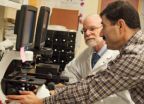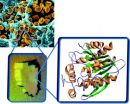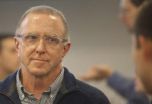(Press-News.org) WA, Seattle (February 17, 2014) – A new study describes the complexity of the new T cell repertoire following immune-depleting therapy to treat multiple sclerosis, improving our understanding of immune tolerance and clinical outcomes.
In the Immune Tolerance Network's (ITN) HALT-MS study, 24 patients with relapsing, remitting multiple sclerosis received high-dose immunosuppression followed by a transplant of their own stem cells, called an autologous stem cell transplant, to potentially reprogram the immune system so that it stops attacking the brain and spinal cord. Data published today in the Journal of Clinical Investigation quantified and characterized T cell populations following this aggressive regimen to understand how the reconstituting immune system is related to patient outcomes.
ITN investigators used a high-throughput, deep-sequencing technology (Adaptive Biotechnologies, ImmunoSEQTM Platform) to analyze the T cell receptor (TCR) sequences in CD4+ and CD8+ cells to compare the repertoire at baseline pre-transplant, two months post-transplant and 12 months post-transplant.
Using this approach, alongside conventional flow cytometry, the investigators found that CD4+ and CD8+ lymphocytes exhibit different reconstitution patterns following transplantation. The scientists observed that the dominant CD8+ T cell clones present at baseline were expanded at 12 months post-transplant, suggesting these clones were not effectively eradicated during treatment. In contrast, the dominant CD4+ T cell clones present at baseline were undetectable at 12 months, and the reconstituted CD4+ T cell repertoire was predominantly comprised of new clones.
The results also suggest the possibility that differences in repertoire diversity early in the reconstitution process might be associated with clinical outcomes. Nineteen patients who responded to treatment had a more diverse repertoire two months following transplant compared to four patients who did not respond. Despite the low number of non-responders, these comparisons approached statistical significance and point to the possibility that complexity in the T cell compartment may be important for establishing immune tolerance.
This is one of the first studies to quantitatively compare the baseline T cell repertoire with the reconstituted repertoire following autologous stem cell transplant, and provides a previously unseen in-depth analysis of how the immune system reconstitutes itself following immune-depleting therapy.
INFORMATION:
About The Immune Tolerance Network
The Immune Tolerance Network (ITN) is a research consortium sponsored by the National Institute of Allergy and Infectious Diseases, part of the National Institutes of Health. The ITN develops and conducts clinical and mechanistic studies of immune tolerance therapies designed to prevent disease-causing immune responses, without compromising the natural protective properties of the immune system. Visit http://www.immunetolerance.org for more information.
Contact:
Philip Bernstein, PhD
(240) 235 6132
ITNCommunications@immunetolerance.org
Immune Tolerance Network
Office of the Director
1201 Ninth Avenue
Seattle, WA 98101-2795
206-342-6901
Extensive renewal of the T cell repertoire following autologous stem cell transplant in MS
2014-02-17
ELSE PRESS RELEASES FROM THIS DATE:
Finding common ground fosters understanding of climate change
2014-02-17
EAST LANSING, Mich. — Grasping the concept of climate change and its impact on the environment can be difficult. Establishing common ground and using models, however, can break down barriers and present the concept in an easily understood manner.
In a presentation at this year's meeting of the American Association for the Advancement of Science, Michigan State University systems ecologist and modeler Laura Schmitt-Olabisi shows how system dynamics models effectively communicate the challenges and implications of climate change.
"In order to face the ongoing challenges ...
Small non-coding RNAs could be warning signs of cancer
2014-02-17
Small non-coding RNAs can be used to predict if individuals have breast cancer conclude researchers who contribute to The Cancer Genome Atlas project. The results, which are published in EMBO reports, indicate that differences in the levels of specific types of non-coding RNAs can be used to distinguish between cancerous and non-cancerous tissues. These RNAs can also be used to classify cancer patients into subgroups of individuals that have different survival outcomes.
Small non-coding RNAs are RNA molecules that do not give rise to proteins but which may have other ...
New finding points to potential options for attacking stem cells in triple-negative breast cancer
2014-02-17
ANN ARBOR, Mich. — New research from the University of Michigan Comprehensive Cancer Center and Georgia Regents University finds that a protein that fuels an inflammatory pathway does not turn off in breast cancer, resulting in an increase in cancer stem cells. This provides a potential target for treating triple negative breast cancer, the most aggressive form of the disease.
The researchers identified a protein, SOCS3, that is highly expressed in normal cells but undetectable in triple-negative breast cancer. They showed that this protein is degraded in cancers, blocking ...
Religious and scientific communities may be less combative than commonly portrayed
2014-02-17
One of the largest surveys of American views on religion and science suggests that the religious and scientific communities may be less combative than is commonly portrayed in the media and in politics.
Only 27 percent of those surveyed said that they viewed science and religion as being in conflict with each other, with about equal percentages of those people "siding with either religion or science," said Rice University sociologist Elaine Howard Ecklund at the AAAS Annual Meeting. The survey was commissioned by the AAAS Dialogue on Science, Ethics and Religion (DoSER) ...
Uncovering the secrets of tularemia, the 'rabbit fever'
2014-02-17
WASHINGTON D.C. Feb. 16, 2014 -- Tularemia, aka "rabbit fever," is endemic in the northeastern United States, and is considered to be a significant risk to biosecurity -- much like anthrax or smallpox -- because it has already been weaponized in various regions of the world.
At the 58th Annual Biophysical Society Meeting, which takes place Feb. 15-19, 2014, in San Francisco, Calif., Geoffrey K. Feld, a Postdoctoral researcher in the Physical & Life Sciences Directorate at Lawrence Livermore National Laboratory (LLNL), will describe his work to uncover the secrets of the ...
Bacterial superbug protein structure solved
2014-02-17
WASHINGTON D.C. Feb. 16, 2014 -- A research team from Vanderbilt University Medical Center in Nashville, Tenn., is the first to decipher the 3-D structure of a protein that confers antibiotic resistance from one of the most worrisome disease agents: a strain of bacteria called methicillin-resistant Staphylococcus aureus (MRSA), which can cause skin and other infections. The Vanderbilt team's findings may be an important step in combatting the MRSA public health threat over the next 5 to 10 years.
By deciphering the shape of a key S. aureus protein -- an enzyme called ...
Harvesting light, the single-molecule way
2014-02-17
WASHINGTON D.C. Feb. 16, 2014 -- New insights into one of the molecular mechanisms behind light harvesting, the process that enables photosynthetic organisms to thrive, even as weather conditions change from full sunlight to deep cloud cover, will be presented at the 58th Annual Biophysical Society Meeting, taking place in San Francisco from Feb. 15-19.
At the meeting, Hsiang-Yu Yang, a graduate student, and Gabriela Schlau-Cohen, a postdoc in W.E. Moerner's research group at Stanford University, will describe how probing these natural systems at the single molecule level ...
Deep ocean needs policy, stewardship where it never existed
2014-02-17
BEAUFORT, N.C. -- Technological advances have made the extraction of deep sea mineral and precious metal deposits feasible, and the dwindling supply of land-based materials creates compelling economic incentives for deep sea industrialization. But at what cost?
“We’re really in the dark when it comes to the ecology of the deep sea," said Linwood Pendleton, director of the Ocean and Coastal Policy Program at the Nicholas Institute for Environmental Policy Solutions at Duke University. "We know a lot about a few places, but nobody is dealing with the deep sea as a whole, ...
Obesity in Samoa: A global harbinger?
2014-02-17
PROVIDENCE, R.I. [Brown University] — The South Pacific archipelago of Samoa and American Samoa harbors a global health mystery that may seem both remote and extreme but could foretell trends in obesity and related conditions across much of the developing world.
About three-quarters of the U.S. territory's adult population is obese, the highest rate in the world with independent Samoa quickly catching up. Rates of type 2 diabetes top one in five and a recent study found that the elevated obesity rates are present even in newborns.
This pandemic began only a few decades ...
Global perspectives on human biology and health
2014-02-17
CHICAGO --- Three anthropology professors from the Weinberg College of Arts and Sciences at Northwestern University will highlight recent research in biological anthropology Sunday, Feb. 16 at the annual meeting of the American Association for the Advancement of Science (AAAS) in Chicago.
The presentations, part of the symposium "Comparative Advantage: Global Perspectives on Human Biology and Health" will be held from 1:30 to 4:30 p.m. in Crystal Ballroom A at the Hyatt Regency Chicago.
Christopher Kuzawa, professor of anthropology and faculty fellow at the Institute ...




